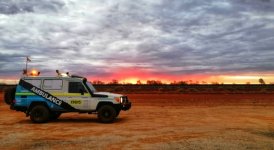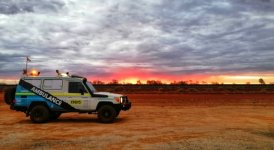- Joined
- Apr 25, 2023
- Messages
- 34
Good morninig team,
Another post this morning for advice from any veterans out there. The subject this morning is smoke reading. I was wondering what you are taught and what you have experienced in this area. We are generally taught Volume, Velocity, Density and Color are the main factors in reading smoke down under. I was wondering what simiple rules you have come up with in your experience with regards to the following or if you have a different method/process of reading the smoke.
Any advice experience here would be appreciated.
I attached a picture of one of our medical vehicles for your troubles. This is what we use in the Pilbara (you guys would probably call it the outback) a converted 4WD Toyota Landcruiser. The mining industry in Australia runs on these vehicles. Normally driven by one of our Paramedics accompanied by what we call an Emergency Services Officer (ESO) in the private sector. They are trained EMT's competant in SCBA, Structural fire, HAZMAT, Rope Rescue, Confined Space Rescue and Road Crash Rescue
ESO's make on average $140,000 AUD ($92,000USD) This is for entry level, more senior guys ca get up to $175,000 AUD ($115,000). the best thing is you only work 6 months of the year to earn that (One week on, one week off), and all expenses are paid when your away!!!
Looking forward to hearing back from anyone.
Jess
View attachment 34481
Another post this morning for advice from any veterans out there. The subject this morning is smoke reading. I was wondering what you are taught and what you have experienced in this area. We are generally taught Volume, Velocity, Density and Color are the main factors in reading smoke down under. I was wondering what simiple rules you have come up with in your experience with regards to the following or if you have a different method/process of reading the smoke.
Any advice experience here would be appreciated.
I attached a picture of one of our medical vehicles for your troubles. This is what we use in the Pilbara (you guys would probably call it the outback) a converted 4WD Toyota Landcruiser. The mining industry in Australia runs on these vehicles. Normally driven by one of our Paramedics accompanied by what we call an Emergency Services Officer (ESO) in the private sector. They are trained EMT's competant in SCBA, Structural fire, HAZMAT, Rope Rescue, Confined Space Rescue and Road Crash Rescue
ESO's make on average $140,000 AUD ($92,000USD) This is for entry level, more senior guys ca get up to $175,000 AUD ($115,000). the best thing is you only work 6 months of the year to earn that (One week on, one week off), and all expenses are paid when your away!!!
Looking forward to hearing back from anyone.
Jess
View attachment 34481

Last edited:

